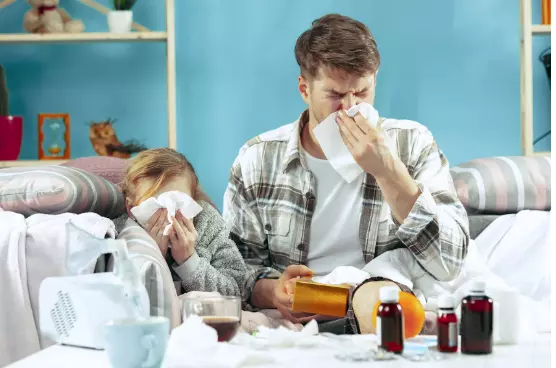
Common colds and allergic rhinitis, which appear more prominent in some seasons, are diseases that greatly reduce the quality of life of the person and cause loss of school/work days.
Since the symptoms are similar, allergic rhinitis and the common cold are often confused with each other. However, these diseases are completely different from each other in terms of both their mechanisms and treatments.
In this article, we will try to explain the differences between these two diseases, the way they occur, and the methods of prevention and the relief of symptoms.
-
Allergic Rhinitis
Allergic rhinitis usually begins at a young age. Complaints arise when a particular allergen is encountered. Symptoms of allergic rhinitis may last all year or may appear more prominently in some seasons, mostly in spring. If there is an allergic condition in the mother or father, it is also more common in children.
-
Symptoms Of Allergic Rhinitis
Rhinitis is a common disease that affects human health and quality of life.
Symptoms:
- Runny nose and nasal congestion
- Itchy nose
- Sneeze
- Tearing eyes
- Postnasal drip
- Tickle in throat
- Chronic cough
In people with allergic rhinitis, sinusitis, nasal flesh growth, asthma, and skin reactions are more common than in normal people.
-
Causes Of Symptoms
Allergic rhinitis, whose symptoms occur during the flowering season of plants, is called hay fever.
- Tree pollen in spring,
- Grass pollen in early summer,
- Weed pollen in late summer and autumn are responsible for the disease.
Causes of allergic rhinitis whose symptoms last year-round are
- House dust mites,
- Mold fungi,
- Animal dander.
While under the age of five, allergens originating from the indoor environment are usually effective, over the age of 5, allergens from the external environment are effective.
-
Best Ways To Avoid Symptoms
Avoiding the effects that cause allergic rhinitis is the most important part of treatment. Determining the factors related to allergies and taking precautions should be the first step.
Accordingly in seasons when pollen density increases:
- Windows should be kept closed and an "air conditioner" should be used instead of a "fan".
- Outdoor activities should be restricted, freshly cut grass should be avoided and, if necessary, masks to block allergens should be worn.
- When you come home, clothes should be changed, hair should be washed and a shower should be taken.
- In the rooms where you spend a long time, items that will keep dust on (carpets, thick curtains, woolens, plush toys, etc.) should not be kept.
- Potted plants that are a source of mold should not be kept at home and gardening should not be done.
- The areas (bathroom, kitchen) and air conditioners where molds caused by moisture are seen should be cleaned in a timely manner.
-
Common Cold
It is an infectious disease caused by more than a hundred different viruses. Different viruses ingested through the mouth, nose, and eyes cause different severity of clinical picture.
-
Symptoms Of Common Cold
The symptoms of the disease are generally similar to each other.
These are mainly:
- Sneeze
- Runny and/or stuffy nose
- Sore throat and cough
- Body aches
- Fatigue and mild fever
The first symptoms appear 1-3 days after exposure to the virus. The disease is more common in winter and children are more affected. The common cold lasts approximately 1 week to 10 days after the virus is acquired.
-
Causes Of Common Cold
Ways of transmission of the disease:
- Inhalation of viruses that suspended in the air
- Contacting people/stuff infected with the virus
- Weak immune systems and smoking are also reasons that increase the risk factor.
-
Best Ways To Avoid Symptoms
In order to prevent the disease, first of all, measures should be taken to prevent the spread of viruses.
These measures are while the disease is in question:
- Using tissue and throwing it away immediately after use,
- Washing hands and keeping hygienic areas at home (bathroom, kitchen, toilet) clean,
- Not sharing the touched items with others,
- Avoiding close contact with healthy people,
While being healthy:
- Eating right,
- Exercising,
- Getting enough sleep
- Coping with stress
Increase resistance and provide protection against such diseases.
-
Treatments That Can Be Done At Home
When you get sick, you should definitely see a doctor. But there are things you can do at home to relieve the symptoms of both diseases and get some relief.
Here's what you can do to relieve symptoms:
- Saltwater: Put 1 teaspoon of salt and a pinch of baking soda into 2 glasses of hot water. Inhale some of this solution into the nostril. Gently blow your nose to remove excess mucus and solution. Follow the same process with the other nostril.
- Steam: Add 3 or 4 drops of any essential oil of your choice, such as eucalyptus, peppermint, rosemary, or tea tree oil. Cover your head with a towel and carefully lean it over the bowl. Inhale the steam deeply for 5 to 10 minutes and blow your nose well.
- Mint and lemon
- Ginger honey
- Cinnamon Honey Milk
- lemon linden
- Vitamin C
- Throat lozenges
Allergic rhinitis (Hay fever) and cold symptoms can be confused with each other. If there is no complication in allergic diseases, there is no fever. Mild fever in the common cold, high fever and fever-related weakness, and joint and muscle aches in influenza infection.
